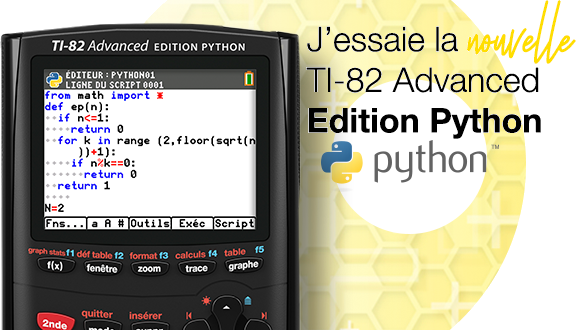Introduction
Wikipédia wrote:« L'une des motivations majeures à la définition du langage$mathjax$\TeX$mathjax$et au développement du logiciel […] était de faciliter la composition de formules mathématiques tout en garantissant une qualité professionnelle à l'impression. Sa réussite dans la réalisation de ces deux buts a été la cause du succès de$mathjax$\TeX,$mathjax$et plus tard de$mathjax$\LaTeX$mathjax$, auprès de la communauté scientifique.$mathjax$\TeX$mathjax$est en effet le langage le plus utilisé pour la composition et la restitution de formules mathématiques complexes à l'écran. »
Ainsi, comme expliqué par Monsieur Wikipédia,
Fini, donc, les exposants et les indices en unicode qui vous prenaient trop de temps pour écrire sur le forum, depuis que Adriweb a permis l’utilisation de ce langage sur le site de TI-Planet.
Ce langage n’est pas particulièrement attractif lorsque l’on en voit un bout de code pour la première fois, cependant, vous ne serez pas déçu lorsque vous découvrirez ses potentialités.
Avant de commencer…
Tout d’abord, pour écrire en \LaTeX sur le forum, vous devrez placer votre code dans les balises
Vous verrez sans arrêt les symboles
\ ou encore { }, il faut juste s’y habituer, l’antislash appelle une fonction, et les accolades servent à y inscrire les paramètres. Enfin, les crochets ouvrants et fermants peuvent être utilisés pour préciser les options d’une fonction.Etant donné que vous vous trimbalez dans un environnement « maths » dans ces balises, vous devrez utiliser la commande
\text{votre_texte} pour insérer du texte à l’intérieur de votre forule.1ère partie : mathématiques simples « inline »
Fonctions de base :
| Commande | Exemple de code | Exemple mis en forme | |
| Exposant | ^ | x^2 | $mathjax$x^2$mathjax$ |
| Indice | _ | {(u_n)}_{n\in\mathbb{N}} | $mathjax${(u_n)}_{n\in\mathbb{N}}$mathjax$ |
| Fraction | \dfrac{a}{b} | \dfrac{ax^2+bx+c}{dx^2+ex+f} | $mathjax$\dfrac{ax^2+bx+c}{dx^2+ex+f}$mathjax$ |
| Racine n-ième | \sqrt[n]{x} | \sqrt[12]{2} | $mathjax$\sqrt[12]{2}$mathjax$ |
| Produit (point) | \cdot | a\cdot b | $mathjax$a\cdot b$mathjax$ |
| Produit (croix) | \times | a\times b | $mathjax$a\times b$mathjax$ |
Sommes, produits, intégrations, limites et logarithmes :
| Commande | Exemple de code | Exemple mis en forme | |
| Somme | \sum | \sum\limits_{k = 0}^\infty k | $mathjax$\sum\limits_{k = 0}^\infty k$mathjax$ |
| Produit | \prod | \prod\limits_{i = 1}^n {\frac{n}{i^2}} | $mathjax$\prod\limits_{i = 1}^n {\frac{n}{i^2}}$mathjax$ |
| Intégration | \int | \int_{a}^{a} f(x) \mathrm{d}x = 0 | $mathjax$\int_{a}^{a} f(x) \mathrm{d}x = 0$mathjax$ |
| Limite | \lim | \lim _{{x\to 0}}{\frac {\cos(x)-1}{x}}=0 | $mathjax$\lim _{{x\to 0}}{\frac {\cos(x)-1}{x}}=0$mathjax$ |
| Logarithme | \log | \log_b\left(\frac{x}{y}\right) = \log_b x - \log_b y | $mathjax$\log_b\left(\frac{x}{y}\right) = \log_b x - \log_b y \,$mathjax$ |
Modulo, congruences :
| Commande | Exemple de code | Exemple mis en forme | |
| Congruences | \equiv | a \equiv b | $mathjax$a \equiv b$mathjax$ |
| Modulo (type 1) | \bmod | a \equiv b \bmod n | $mathjax$a \equiv b \bmod n$mathjax$ |
| Modulo (type 2) | \pmod | a \equiv b \pmod n | $mathjax$a \equiv b \pmod n$mathjax$ |
| Modulo (type 3) | \pod | a \equiv b \pod n | $mathjax$a \equiv b \pod n$mathjax$ |
Combinaisons :
| Commande | Exemple de code | Exemple mis en forme | |
| Combinaisons | \dbinom | \dbinom{a}{b} | $mathjax$\dbinom{a}{b}$mathjax$ |
Fonctions :
LaTeX étant un environnement maths, toutes les données saisies seront interprétées comme étant des maths, et donc, en applicant une mise en forme italique aux lettres.
Ainsi, si l’on écrit
chacun de vos besoins :
| Commande | Résultat |
\arccos | $mathjax$\arccos$mathjax$ |
\cos | $mathjax$\cos$mathjax$ |
\csc | $mathjax$\csc$mathjax$ |
\exp | $mathjax$\exp$mathjax$ |
\ker | $mathjax$\ker$mathjax$ |
\limsup | $mathjax$\limsup$mathjax$ |
\min | $mathjax$\min$mathjax$ |
\sinh | $mathjax$\sinh$mathjax$ |
\arcsin | $mathjax$\arcsin$mathjax$ |
\cosh | $mathjax$\cosh$mathjax$ |
\deg | $mathjax$\deg$mathjax$ |
\gcd | $mathjax$\gcd$mathjax$ |
\lg | $mathjax$\lg$mathjax$ |
\ln | $mathjax$\ln$mathjax$ |
\Pr | $mathjax$\Pr$mathjax$ |
\sup | $mathjax$\sup$mathjax$ |
\arctan | $mathjax$\arctan$mathjax$ |
\cot | $mathjax$\cot$mathjax$ |
\det | $mathjax$\det$mathjax$ |
\hom | $mathjax$\hom$mathjax$ |
\lim | $mathjax$\lim$mathjax$ |
\log | $mathjax$\log$mathjax$ |
\sec | $mathjax$\sec$mathjax$ |
\tan | $mathjax$\tan$mathjax$ |
\arg | $mathjax$\arg$mathjax$ |
\coth | $mathjax$\coth$mathjax$ |
\dim | $mathjax$\dim$mathjax$ |
\inf | $mathjax$\inf$mathjax$ |
\liminf | $mathjax$\liminf$mathjax$ |
\max | $mathjax$\max$mathjax$ |
\sin | $mathjax$\sin$mathjax$ |
\tanh | $mathjax$\tanh$mathjax$ |
En savoir plus….
Pour plus d’informations, veuillez visiter les tutoriels Wikipédia comme celui-ci http://fr.wikibooks.org/wiki/LaTeX/%C3%89crire_des_math%C3%A9matiques
qui sont bien plus complets que mon petit amuse-gueule.
2ème partie : mathématiques multilignes « block »
Nous allons voir dans cette partie les différents agencements que vous pouvez faire entre deux lignes de calculs, ou encore les environnements 2D comme les matrices.
L’environnement « array »
LaTeX peut fonctionner sans aucun environnement particulier, comme nous l’avons fait jusqu’à présent, mais on peut aussi utiliser ses nombreux
environnements disponibles pour les mathématiques.
En LaTeX, on début un environnement par
\begin{nom_de_l’environnement} et on le clos par \end{nom_de_l’environnement}.Ainsi, pour travailler dans l’environnement « array », il faudra utiliser
\begin{array} et \end{array}.Cet environnement est utile pour créer des sortes de tableaux sans contours et donc pour pouvoir organiser les expressions mathématiques. Ce n’est pas évident de se représenter à première vue ce que cela peut donner, mais vous verrez que cela s’avère très pratique.
Voici un exemple : on veut simplifier l’expression
- Code: Select all
(1+a)(2+b)=1 \times 2 + 1 \times b + a \times 2 + a \times b
Sauf que maintenant, on aimerait réécrire le
= en dessous du premier ainsi que la réponse, de sorte à ce que tout soit parfaitement aligné.C’est possible avec l’environnement
array.Voilà comment procéder :
- Code: Select all
\begin{array}{rcl} % rcl : alignement des trois colonnes (right center left respectivement)
(1+a)(2+b) &=& 1 \times 2 + 1 \times b + a \times 2 + a \times b\\
&=& ab + 2a + b + 2
\end{array}
Rendu :
(1+a)(2+b) &=& 1 \times 2 + 1 \times b + a \times 2 + a \times b\\
&=& ab + 2a + b + 2
\end{array}$mathjax$
L’environnement « matrix »
Une matrice de base peut être créée en utilisant l'environnement
matrix. La structure est similaire à array, les entrées sont données par ligne, avec des colonnes séparées par esperluette & et une nouvelle ligne séparée par les deux antislashs \\. Les matrices sont généralement encadrées (sauf par défaut) de différentes façons, et tant que c'est possible, utilisez les commandes \left and \right qui servent à encadrer une expression par des parenthèses, crochets accolades etc. en adaptant leur taille (par exemple : \left( \dfrac {a}{b}\right) donne | Code | Rendu en $mathjax$\LaTeX$mathjax$ |
| $mathjax$\begin{matrix} a & b \\ c & d \end{matrix}$mathjax$ |
| $mathjax$\begin{pmatrix} a & b \\ c & d \end{pmatrix}$mathjax$ |
| $mathjax$\begin{bmatrix} a & b \\ c & d \end{bmatrix}$mathjax$ |
| $mathjax$\begin{vmatrix} a & b \\ c & d \end{vmatrix}$mathjax$ |
| $mathjax$\begin{Vmatrix} a & b \\ c & d \end{Vmatrix}$mathjax$ |
Exemple:
- Code: Select all
\mathsf{A}_{m,n} = \begin{Vmatrix}
a_{1,1} &a_{1,2} &\cdots &a_{1,n} \\
a_{2,1} &a_{2,2} &\cdots &a_{2,n} \\
\vdots & \vdots & \ddots &\vdots \\
a_{m,1} &a_{m,2} &\cdots &a_{m,n}
\end{Vmatrix}
a_{1,1} &a_{1,2} &\cdots &a_{1,n} \\
a_{2,1} &a_{2,2} &\cdots &a_{2,n} \\
\vdots & \vdots & \ddots &\vdots \\
a_{m,1} &a_{m,2} &\cdots &a_{m,n}
\end{Vmatrix}$mathjax$
Autres environnements utiles
Pour des fonctions par morceaux ou des définitions utilisant des conditions, utilisez l'environnement
cases :Exemple:
- Code: Select all
\left| x\right| =
\begin{cases}
\hphantom{-}x &,\, \text{si }x\geq 0 ,\\
-x&,\, \text{si }x<0
\end{cases}
\begin{cases}
\hphantom{-}x &,\, \text{si }x\geq 0 ,\\
-x&,\, \text{si }x<0
\end{cases}$mathjax$
Pour scinder de longs blocs de math, utilisez l'environnement
split3ème partie : différents exemples variés
| Expression mathématique | Code Latex |
$mathjax$\frac{2}{3}$mathjax$ | \frac{2}{3} |
$mathjax$\frac{a}{b}$mathjax$ | \frac{a}{b} |
$mathjax$\sqrt{x}$mathjax$ | \sqrt{x} |
$mathjax$\int_{a}^{b}f(x)dx$mathjax$ | \int_{a}^{b}f(x)dx |
$mathjax$\vec{AB}$mathjax$ | \vec{AB} |
$mathjax$x^n$mathjax$ | x^n |
$mathjax$ax^n+bx^{n-1}+cx^{n-2}$mathjax$ | ax^n+bx^{n-1}+cx^{n-2} |
$mathjax$U_1,U_2,\cdots,U_n,U_{n+1}$mathjax$ | U_1,U_2,\cdots,U_n,U_{n+1} |
$mathjax$\widehat{AOB}$mathjax$ | \widehat{AOB} |
$mathjax$\infty$mathjax$ | \infty |
$mathjax$\sum_{k=a}^{b}k^2$mathjax$ | \sum_{k=a}^{b}k^2 |
$mathjax${ax+by=c}$mathjax$ | ax+by=c |
$mathjax$\alpha\beta\gamma\delta...\omega$mathjax$ | \alpha\beta\gamma\delta...\omega |
$mathjax$\mathbb{N},\mathbb{Z},\mathbb{D},\mathbb{Q},\mathbb{R},\mathbb{C}$mathjax$ | \mathbb{N},\mathbb{Z},\mathbb{D},\mathbb{Q},\mathbb{R},\mathbb{C} |
$mathjax$f:x\mapsto x^2$mathjax$ | f:x\mapsto x^2 |
$mathjax$\lim_{x\to+\infty}f(x)$mathjax$ | \lim_{x\to+\infty}f(x) |
$mathjax$\pi$mathjax$ | \pi |
$mathjax$\ln(ax^2+bx+c)$mathjax$ | \ln(ax^2+bx+c) |
$mathjax$\cos(ax+b)$mathjax$ | \cos(ax+b) |
$mathjax$\sin(x+2\pi)$mathjax$ | \sin(x+2\pi) |
$mathjax$\mathbb{N}=\{0;1;2;3;.....\}$mathjax$ | \mathbb{N}=\{0;1;2;3;.....\} |
$mathjax$\cap\cup\subset\in\notin\forall\exists$mathjax$ | \cap\cup\subset\in\notin\forall\exists |
$mathjax$\Longleftarrow\Longleftrightarrow\Longrightarrow$mathjax$ | \Longleftarrow\Longleftrightarrow\Longrightarrow |
$mathjax$\dfrac{ax^3+bx^2+c}{d+\dfrac{ex^2+f}{gx+d}}$mathjax$ | \dfrac{ax^3+bx^2+c}{d+\dfrac{ex^2+f}{gx+d}} |
Bonus :
\fbox{Ainsi, d'après le lemme de Gauss, $a^b|{n!}$} donne :Conclusion
J’espère que ce micro-tutoriel vous aura servi, si vous en voulez plus, demandez moi j’ajouterai au fur et à mesure les informations que vous me
demanderez.
Amusez vous bien avec
























